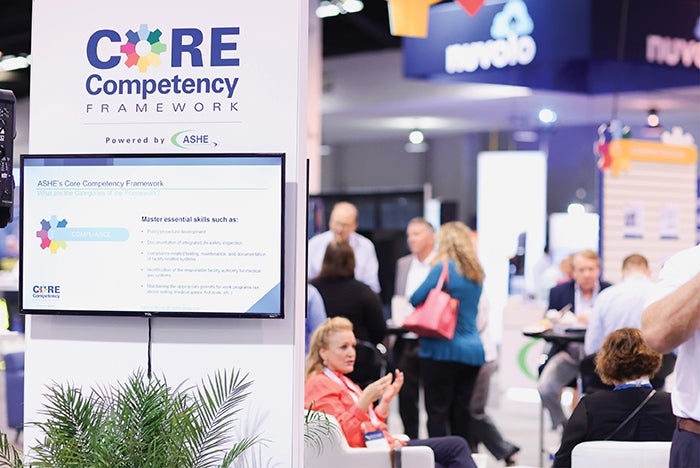Engaging your core competencies

The Project Management Competency helps facilities managers see a project through from initiation to closure.
Image by Getty Images
In health care facilities management, if you don’t like what you’re working on, just wait an hour — it’ll change. Many in the field feel this take on the old Midwestern weather adage aptly applies given the wide variety and quickly changing roles and duties a facilities manager handles in any given day or week: They might start out managing the repair of a boiler, then answer an accreditation surveyor’s question, then defend a capital equipment budget in the board room.
A risk of constantly needing to quickly change hats is becoming a jack of all trades but a master of none. Further complicating things, training under these varied health care facilities hats can often be done fully on-the-job versus the classroom — with people being taught “my way” of performing a task but not necessarily the best way.
To help health care facilities managers identify which areas of expertise are most important in their field and fill any gaps or weaknesses they may have in those areas, the American Society for Health Care Engineering (ASHE) has created the first comprehensive, crowdsourced Health Care Facilities Core Competency Framework. The framework charts eight key skills of health care facilities management and offers education, resources and tools to help professionals gain best practice expertise and fill knowledge gaps in each area.
Health care facilities managers must have a combination of skills, knowledge and ability to effectively lead a multi-disciplinary team that can prioritize an ever-adapting list of issues.
By becoming an expert in each of the framework’s eight core competencies, facilities managers will gain confidence that they can provide patients and providers a safe, comfortable and cost-efficient physical health care environment and also be primed for advancement in the field, says Adam Bazer, MPD, senior director of knowledge product development at ASHE.
“ASHE’s mission is optimizing health care facilities, and the Core Competency Framework is how we are helping professionals optimize their operations and their actionable knowledge in each area of the field,” Bazer says. “The framework’s strength is that it is comprehensive and built with each segment of the profession in mind. ASHE is bringing these key competencies together to help people become the well-rounded professionals they need to be to succeed.”
Eight core areas
Work on the Core Competency Framework started nearly a decade ago, with ASHE volunteers and staff first working to identify the key areas where professionals should focus their efforts and gain expertise.
To start, a facilities management job task analysis was performed based on feedback from a vast array of professionals in the field, which outlined a typical day, week and month of a facilities management professional. That job task analysis was combined with elements of the Certified Health Care Facility Manager (CHFM) certification, which outlines key specific areas of the job a person must understand to be successful. After extensive work refining this data by member-led committees, discussions in the field and analysis by the ASHE Advisory Board, the eight core competencies of health care facilities management were identified. They are:
- Compliance;
- Sustainability;
- Finance;
- Energy Management;
- Maintenance and Operations;
- Project Management;
- Assessing Risk;
- Administration.
Professionals who gain expertise in each of these areas can ensure that their health care facilities are performing optimally and fully supporting the delivery of vital health care. By using the resources offered by ASHE within the Core Competency Framework — which are listed on the framework’s webpage — any professional, regardless of their role on the facilities management team, can grow their expertise and advance in their career. The framework is especially helpful for people who are new to the profession or coming to health care facilities management from another field, Bazer says.
“Take the Finance Competency, for example. As a health care facilities professional, you need to understand all aspects of budgeting, capital equipment planning, property and equipment leasing, etc., and actualize that knowledge so you can manage the budget while maintaining a high level of quality for a health care facility,” Bazer says. “The resources available in this competency help facilities professionals understand the impact the facilities department has on an organization’s ability to deliver care. Just as importantly, the framework teaches how to be an effective advocate for department needs to senior executives making decisions on the budget.”
Every professional in the facilities management field will need expertise in each of the eight core competencies, though the level of importance of each competency will vary based on role and organization. For example, a construction manager will need more expertise in project management and assessing risk, while a facilities manager will need extensive expertise in compliance and administration.
“The framework’s goal is to build knowledge for each member of the team in each area, at all skill levels, because everyone on a facilities team has an important part to play in optimizing the health care physical environment,” Bazer says. “With support from our incredible community of members from across the country, ASHE has produced high-quality tools and advice on how to effectively perform the detailed tasks within each competency. All of our resources and education have been aligned with the core competencies so that as you are navigating your career, you can get help understanding compliance, sustainability or wherever your gaps are and be able to leverage those resources in your career, no matter where you are starting out.”
Body of knowledge
To help professionals advance in each area of the Core Competency Framework, ASHE is advancing its body of knowledge through a series of handbooks and education courses on each competency.
The Health Care Facilities Management Essentials Series offers the first consistent, authoritative resource on health care facilities management to ensure that all professionals can easily obtain the same, essential baseline information they need to do their jobs effectively. The series offers best practices collected from the field’s leading experts in each competency area. The handbooks offer a repository of information one can continually reference, while the interactive education programs allow professionals to practice implementing the key concepts.

ASHE’s Core Competency Framework was rolled out at this year’s Health Care Facilities Innovation Conference™ in Anaheim, Calif.
Image courtesy of ASHE
“People were learning their own way to approach these competencies on the job, but what leaders in the field like Chad Beebe [deputy executive director for ASHE Regulatory Affairs], Tim Adams [former director of leadership development for ASHE] and Jonathan Flannery [senior associate director for ASHE Regulatory Affairs] realized at the inception of the Core Competency Framework was that ASHE needed to document and teach to a definitive and consistent best practice for each of these areas,” Bazer says.
ASHE has also launched a series of Core Competency Clinics offered at major conferences and through its chapters, which provide live in-person training on each competency and review the resources available to dive deeper into the topics.
The entire ASHE inventory of education and publications content has been reorganized around the Core Competency Framework, with the best available content in each area highlighted on the framework’s website. Sessions at ASHE’s rebranded annual conference, the Health Care Facilities Innovation Conference™, as well as other training have been reorganized around the core competencies. Four knowledge levels have also been developed and are being assigned to content to help professionals gauge where they are in terms of their expertise and how to push that knowledge further, Bazer says.
“As the ASHE community looks to advance within the Core Competency Framework, these knowledge levels are a great way for people to not look at the whole journey ahead of them but instead take one step forward,” Bazer says. “People who need to understand the basics of a competency can seek the foundations knowledge level. People looking for new ideas on specific topics can find that in the exploratory knowledge level. People who need to apply new solutions and have an immediate on-the-job impact can look for applied/technical knowledge level resources. And for our management and senior executives, to help them find those ‘aha!’ moments and confront challenges, ASHE offers content at the management/strategic knowledge level.”
Future of the framework
ASHE is not only asking its members to assess their core competency gaps but is also doing the same exercise internally with its content.
The ASHE member-led Operations Optimization Committee, as part of its work to standardize how professionals in the field can best optimize their performance, has been analyzing ASHE’s content against the job task analysis that informed the framework and identifying gaps in the resources offered by the association. ASHE then is taking that gap analysis and working to create new educational content that fills those gaps to better help members grow their expertise in every area of their job.
“We are trying to help all our members and, subsequently, their organizations grow, from the entry-level professional all the way up to facilities leaders entering the C-suite. In order to get more facilities managers in the C-suite, we need to give members the tools and resources they need to grow into that role,” Bazer concludes.
RELATED ARTICLE: Facilities fundamentals covered in revamped education course
Those new to the health care facilities management field wondering where to start their education can turn to the newly updated Fundamentals of Health Care Facility Management Program.
This in-person or live online American Society for Health Care Engineering (ASHE) education course offers an overview of key knowledge needed to work in health care facilities management and touches on all areas of the Core Competency Framework. Developed for those entering or interested in the health care facilities management profession, this workshop provides attendees a strong foundational base that they can expand upon through the Core Competency Framework.
“While the framework handbooks and e-learning courses are excellent deep dives on competencies, this course provides a higher-level review while also offering people the opportunity to interact and ask questions of ASHE’s industry veteran faculty, who have tens of thousands of hours of real work experience,” says Adam Bazer, MPD, senior director of knowledge product development at ASHE.
The course teaches the impact the physical environment has on patient outcomes, patient satisfaction and reimbursement. Codes and standards applicable to health care facilities are reviewed, and attendees learn the driving factors that affect the operations and maintenance of health care facilities, including regulatory requirements, clinical needs and financial management.
“Health care facilities professionals are an integral part of the care team, something more and more clinicians and patients understand, especially after the COVID-19 pandemic where, for example, ASHE members were turning parking lots into points of care,” Bazer says. “Facilities management expertise is critical for saving lives — you can’t operate on a patient if the operating room doesn’t have electricity or the steam needed to sterilize the surgeon’s instruments isn’t working. This course starts with this principle and teaches the core elements of the competencies for facilities management success.”
To learn more, visit ASHE's website.
RELATED ARTICLE: Examples from the Core Competency Framework
Below are three areas of the Core Competency Framework, including a description of what each competency is, how expertise is demonstrated in the competency, on-the-job examples of that competency in action and resources available to advance knowledge in the competency.
Health care facilities managers oversee the health care physical environment and ensure compliance with associated regulatory requirements in a way that ensures patient care and safety is the foremost priority for the entire facilities management team.
This is demonstrated through, but not limited to, possessing a comprehensive working knowledge of health care physical environment-related regulatory requirements for accreditation at the federal/state/local levels as well as an understanding of the actions required to ensure compliance through:
- Policy/procedure development.
- Documentation of integrated life safety inspection.
- Compliance-related testing, maintenance and documentation of facility-related systems.
- Identification of the responsible facility authority for medical gas systems.
- Maintaining the appropriate permits for work programs (e.g., above ceiling, medical gases and hot work).
Examples of available resources include:
- Understanding Health Care Compliance — The Facilities Manager’s Handbook. This is a comprehensive overview of health care facilities compliance that maps the complex regulatory landscape and shares best practices in compliant facilities management.
- Physical Environment Survey Readiness. Facilities professionals can leverage continuous code compliance and reduce survey mistakes through the Life Safety, Emergency Management and The Care Environment modules.
- Hazard Vulnerability Assessment Tool. Facilities professionals can use this tool to score emergency preparedness using the all-hazards approach and identify the potential hazards that need the most attention for exercise, mitigation and/or planning.
Project management is the process of seeing a project through from initiation to closure. By building on their project management competency, facilities professionals will learn how to avoid miscommunications and unforeseen project hurdles while also saving their organization valuable time and resources during vital planning, design and construction projects.
Critical skills for this competency include:
- Managing contracts.
- Selecting proper construction delivery methods.
- Using facility data to enhance/improve design, construction and operations.
- Mitigating impacts to patient care and staff during construction (e.g., Pre-Construction Risk Assessment/Infection Control Risk Assessment (ICRA)/Interim Life Safety Measures).
- Planning for an effective and seamless handoff between planning, design and construction and facility operations.
Examples of available resources include:
- “Building Success in Health Care Project Management.” This e-learning series guides facilities professionals through all stages of a health care construction project, from inception and team building to planning, design, construction, completion and post-occupancy.
- The Facilities Manager’s Handbook for Health Care Project Management. This handbook lays out the processes and flow of a health care project, including planning, design and construction, taking a sequential approach to each topic.
- Health Care Construction Workshop. This helps attendees prepare to work in the unique health care physical environment and learn how to identify, mitigate and document health care construction risks.
Patients and their loved ones rely on safe, healthy and clean facilities, and it is up to facilities managers and staff to ensure that the people in their facilities are not exposed to unnecessary harm. This is accomplished by evaluating the severity, likelihood and probability of risk and implementing appropriate measures to mitigate that risk.
The Assessing Risk Competency includes skills such as:
- Developing and implementing management plans, policies and procedures for risk categories.
- Utilizing ICRA 2.0 and interim as well as alternate life safety measure programs.
- Operation of the following facilities programs: fire safety management, all-hazards emergency management, utility management (including utility incident response, water management and ventilation management), worker safety, security management (including violence in the workplace, active shooter, cybersecurity and appropriate access) and hazardous materials programs.
Examples of available resources include:
- ASHE ICRA 2.0™ Training Program. This provides health care facilities with the tools to train and onboard new staff to complete the ASHE ICRA 2.0 process and personalize the infection prevention strategy for a site.
- ASHE Wet Location Tool. This tool provides a framework for a risk analysis to determine if an operating room should be considered a wet-procedure location.
- Patient Safety Tools and Resources: Preventing Self Harm and Ligature Risks. Facilities professionals can use this tool to create ligature-resistant environments when 1:1 continuous observation is not practical.
Chris Dimick is content development and communications manager at the American Society for Health Care Engineering.




